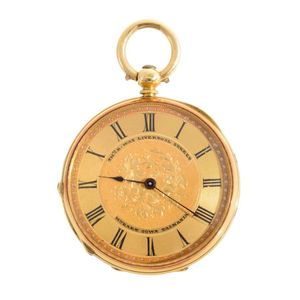French Electromechanical Wall Clock with Marble Backplate
You must be a subscriber, and be logged in to view price and dealer details.
Subscribe Now to view actual auction price for this item
When you subscribe, you have the option of setting the currency in which to display prices to $Au, $US, $NZ or Stg.
- Back Plate - On many types of clocks, the movement operates between two plates, usually made of brass, one at the back, and the other at the front, which forms a mount for the dial.
On English bracket, mantle and table clocks the backplate was often visible through a glass door or panel from the late 17th century, and could be profusely engraved with scrolling decorations, flowers, foliage, birds, and figures. The engraving could also include the maker?s name.
The amount of engraving reduced and became simpler as the 18th century progressed, and by 1800, had been reduced to a border, often with the maker's name in the centre. By the early 1800s all decoration had ceased, and only the maker's name was added, and by the Victorian era, most bracket, mantle and table clocks had no engraving. - Movement - The technical name for the workings of a clock or watch, and does not include the dial or case.
- Pendulum - The pendulum was discovered around 1602 by Galileo Galilei, and was adopted for time keeping by the Dutch mathematician and natural philosopher, Christiaan Huygens, who excelled in astronomy, physics, and horology.
The pendulum comprises a metal rod usually of brass or steel with a metal disk, known as a bob, at the end. The movement of the pendulum is driven by weights or a spring, and as a pendulum swings in a regular arc, it was found accuracy could be controlled to within a few seconds a week.
Timekeeping can be adjusted by changing the height of the bob on the rod, making the pendulum either swing slower or faster.
The disadvantage of the pendulum was that changes in temperature also changed the length of the pendulum, interfering with the accuracy of the clock, and so in the 18th century two types of mercurial pendulums were invented which countered the movement in the steel rod.
The pendulum was the world's most accurate timekeeping technology until the invention of the quartz clock, regulated by a quartz crystal, in 1927.
This item has been included into following indexes:
Visually similar items

A lady's gold open face pocket watch J M Wendt, Adelaide crown wind, pin set, gold dial. Base metal curvette. 14ct gold engraved case. Weight 38.7 grams.

An open face pocket watch, white dial, Roman numerals, subsidiary seconds dial on a plate movement in a rolled gold case. Not working.

An antique silver pocket watch on fob chain, sterling silver, marked to dial John Forrest, James Haughton. (1826 - 1925) London, 19th century, full sized round case, white enamel dial, black Roman numerals, sub dial, key wind, suspended from a sterling fob

A rare early antique Australian ladies open face gold pocket watch, key wind and set movement, circular gold dial with Roman numerals, signed dial, movement and curvet, Thos. B. Way Liverpool Street Hobart Town Tasmania, case signed G. Chopard, 18ct gold c
